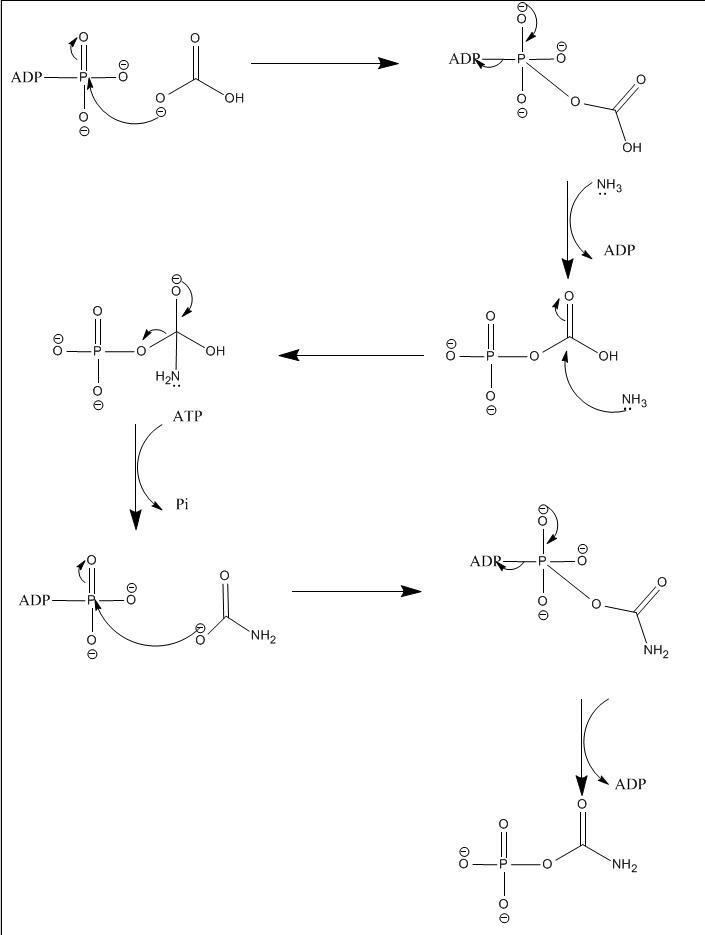Symbol CPS1 HUGO 2323 RefSeq NM_001875 | Entrez 1373 OMIM 608307 UniProt P31327 | |
 | ||
Carbamoyl Phosphate Synthetase I is a ligase enzyme located in the mitochondria involved in the production of urea. Carbamoyl phosphate synthetase I (CPS1 or CPSI) transfers an ammonia molecule from glutamine or glutamate to a molecule of bicarbonate that has been phosphorylated by a molecule of ATP. The resulting carbamate is then phosphorylated with another molecule of ATP. The resulting molecule of carbamoyl phosphate leaves the enzyme.
Contents
Structure of Carbamoyl Phosphate Synthetase I
In E. coli CPSI is a heterodimer with a small subunit and a larger subunit with about 382 and 1073 amino acid residues in size, although in mammals (and other vertebrates) the CPSI protein is encoded by a single gene. The small subunit contains one active site for the binding and deamination of glutamine to make ammonia and glutamate. The large subunit contains two active sites, one for the production of carboxyphosphate, and the other for the production of carbamoyl phosphate. Within the large subunit there are two domains (B and C) each with an active site of the ATP-grasp family. Connecting the two subunits is a tunnel of sorts, which directs the ammonia from the small subunit to the large subunit.
Mechanism of Carbamoyl Phosphate Synthetase I
The overall reaction that occurs in CPSI is:
2ATP + HCO3− + NH4+ --> 2ADP + Carbamoyl phosphate + Pi
This reaction can be thought of occurring in four distinct steps.
- Bicarbonate is phosphorylated
- Ammonia is cleaved from glutamine (glutaminase) or glutamate (glutamate dehydrogenase)
- The ammonia attacks the carboxyphosphate, resulting in carbamate
- Carbamate is phosphorylated to give Carbamoyl phosphate
Of these four steps, only step two - the deamination of glutamine to get ammonia - is known to have actively participating amino acid residues, Cys269 and His353. The other three steps mostly utilize amino acid residue to form hydrogen bonds with substrates. A video of a simplified version of this mechanism is available here
Recent Mechanism Studies
It has been found that both ATP-binding sites in the large subunit of CPSI are structurally equivalent. A recent study has investigated the interlinking between these two domains (domain B and domain C) and has found evidence that they are coupled. This ATP-binding domain coupling works in a way such that a molecule of ATP binding at one site (domain C) conformationally allows synthesis at the other domain (domain B). If this is the case, carbamoyl phosphate is, in fact, not formed in step 5 (of the included mechanism below) by ejecting ADP but rather in step 4 by protonating the alcohol group and then kicking it off as water.
Regulation
CPSI is regulated by N-acetylglutamate; however, unlike most enzymes it is not allosterically regulated. Instead N-acetylglutamate is an obligate activator of CPS1.
Carbamoyl Phosphate Synthetase I and Metabolism
CPSI plays a vital role in protein and nitrogen metabolism. Once ammonia has been brought into the mitochondria via glutamine or glutamate, it is CPSI’s job to add the ammonia to bicarbonate along with a phosphate group to form carbamoyl phosphate. Carbamoyl phosphate is then put into the urea cycle to eventually create urea. Urea can then be transferred back to the blood stream and to the kidneys for filtration and on to the bladder for excretion.
Health Problems related to Carbamoyl Phosphate Synthetase I
The main problem related to CPSI is genetics-based. Sometimes the body does not produce enough CPSI due to a mutation in the genetic code, resulting in poor metabolism of proteins and nitrogen, as well as high levels of ammonia in the body. This is dangerous because ammonia is highly toxic to the body, especially the nervous system, and can result in retardation and seizures.
